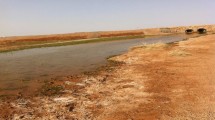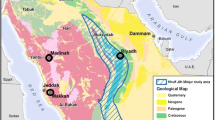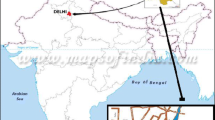Abstract
The present study has been carried out to assess the quality of groundwater and surface water resources of Thettiyar watershed, Kerala, India. Sixty-six water samples were collected during pre-monsoon (April, 2019) and monsoon (July, 2019) season, and analyzed for pH, electrical conductivity (EC), total dissolved solids (TDS), total hardness and major cations and anions and microbiological parameters as well. According to the piper diagram’s plot, Ca and Mg dominate over Na among the cations, and Cl is the most prevalent anion in groundwater throughout both the studied seasons. The hydrochemical analysis of water samples revealed that all the parameters are within the permissible limit except for pH. For microbiological analysis, the samples were tested for total coliform and fecal coliform. Most of the groundwater samples collected have higher total coliform and fecal coliform (E. coli) content than the recommended count by BIS (2012). The pre-monsoon surface water samples owned a maximum number of 3700 cfu/100 ml (TNTC-too numerous to count) of total coliform and 1400 cfu/100 ml (TNTC) of fecal coliform. In monsoon, the number of total coliform and fecal coliform has increased to 3800 cfu/100 ml and 1900 cfu/100 ml respectively. E. coli and total coliform are effectively correlated with each other in both seasons, in accordance with the statistical study. Domestic, sewage dump, and other household wastes are the main sources of bacterial contamination in the study area, which in turn nourishes contaminant organisms. According to the results, the government or municipality should implement an appropriate system for managing solid waste and should take all necessary measures to clean up the study area.









Similar content being viewed by others
Availability of data and materials
Not applicable.
References
Akron, M. O., Amu-Mensah, F. K., Amu-Mensah, M. A., et al. (2019). Seasonal analysis of bacteriological quality of drinking water sources in communities surrounding Lake Bosomtwe in the Ashanti Region of Ghana. Applied Water Science, 9, 82. https://doi.org/10.1007/s13201-019-0959-z
Andrade, L., Boudou, M., Hynds, P., Chique, C., Weatherill, J., & O’Dwyer, J. (2022). Spatiotemporal dynamics of Escherichia coli presence and magnitude across a national groundwater monitoring network, Republic of Ireland, 2011–2020. Science of the Total Environment, 840, 156311.
Andrade, L., O’Dwyer, J., O’Neill, E., & Hynds, P. (2018). Surface water flooding, groundwater contamination, and enteric disease in developed countries: A scoping review of connections and consequences. Environmental Pollution, 236, 540–549.
APHA. (1995). Standard methods for the examination of water and wastewater, American Public Health Association, USA, 14th edition, Washington D.C.
APHA. (1998). Standards methods for the examination of water and wastewater (20th ed.). American Public Health Association.
APHA. (2005). American Public Health Association, Standard methods for the examination of water and wastewater, American Public Health Association (APHA), Washington, DC, USA.
Arumugam, T., Kinattinkara, S., Kannithottathil, S., Velusamy, S., Krishna, M., Shanmugamoorthy, M., & Boobalakrishnan, K. V. (2023). Comparative assessment of groundwater quality indices of Kannur District, Kerala, India using multivariate statistical approaches and GIS. Environmental Monitoring and Assessment, 195(1), 1–30.
Arumugam, T., Kunhikannan, S., & Radhakrishnan, P. (2019). Assessment of fluoride hazard in groundwater of Palghat District, Kerala: A GIS approach. International Journal of Environment and Pollution, 66(1–3), 187–211.
Bartram, J., & Pedley, S. (1996). Water quality monitoring - A practical guide to the design and implementation of freshwater quality studies and monitoring programmes, Published on behalf of United Nations Environment Programme and the World Health Organization.
Berhe, B. A. (2020). Evaluation of groundwater and surface water quality suitability for drinking and agricultural purposes in Kombolcha town area, eastern Amhara region, Ethiopia. Applied Water Science, 10, 127. https://doi.org/10.1007/s13201-020-01210-6
Birmingham, M. E., Lea, L. A., Ndayiminje, N., Nkurikiye, S., Harsh, B. S., Well, J. G., & Ijeming, M. S. (1997). Epidemic cholera in Burnndi, patterns of transmission in the Gadat Rift Valley Lake Region. Lancet, 349, 981–982.
BIS. (2012). Indian standards drinking water specifications IS 10500:2012. Bureau of Indian Standards Indian Stand Drink Water Specification, 2, 11.
Bowen, R. (1986). Groundwater. Springer Science & Business Media.
Chapman, P. J., Kay, P., & Mitchell, G. N. (2013). Surface water quality. In: Holden, J. (Ed.) Water resources: An integrated approach. Routledge, 79–122. ISBN 0415602823.
Chique, C., Hynds, P., Burke, L. P., Morris, D., Ryan, M. P., & O’Dwyer, J. (2021). Contamination of domestic groundwater systems by verotoxigenic Escherichia coli (VTEC), 2003–2019: A global scoping review. Water Research, 188, 116496.
Chique, C., Hynds, P. D., Andrade, L., Burke, L., Morris, D., Ryan, M. P., & O’Dwyer, J. (2020). Cryptosporidium spp. in groundwater supplies intended for human consumption–A descriptive review of global prevalence, risk factors and knowledge gaps. Water research, 176, 115726.
Connor, R. (2015). The United Nations world water development report 2015: Water for a sustainable world (vol 1). UNESCO Publishing.
Daneshmand, S., Huat, B. B., Moayedi, H., & Ali, T. A. M. (2011). Study on water quality parameters of Linggi and Melaka Rivers catchments in Malaysia. Engineering Journal, 15(4), 41–52.
Department of Mining & Geology Kerala. (2016). District survey report of minor. Minerals. Thiruvananthapuram.
Elbeih, S. F. (2015). An overview of integrated remote sensing and GIS for groundwater mapping in Egypt. Ain Shams Engineering Journal, 6(1), 1–15. https://doi.org/10.1016/j.asej.2014.08.008
Fetter, C. W. (1988). Applied hydrogeology, Merrill, Columbus, OH, pp. 261- 264.
Freeze, R. A., & Cherry, J. A. (1979). Groundwater (No. 629.1 F7).
Hem, J. D. (1985). Study and interpretation of the chemical characteristics of natural water, 3rd edition.
Hill, R. A. (1940). Geochemical patterns in Coachella valley. Eos, Transactions American Geophysical Union, 21(1), 46–53.
Hutaisxi, A., Saheki, K., & Horie, S. (1984). Relationships of total coliform, fecal coliform, and organic pollution levels in the Tamagawa River. Bulletin of the Japanese Society of Scientific Fisheries, 54(6), 991–997.
Ifediegwu, S. I. (2022). Assessment of groundwater potential zones using GIS and AHP techniques: a case study of the Lafia district, Nasarawa State, Nigeria. Applied Water Science, 12(1), 1–17.
Jampani, M., Liedl, R., Hülsmann, S., Sonkamble, S., & Amerasinghe, P. (2020). Hydrogeochemical and mixing processes controlling groundwater chemistry in a wastewater irrigated agricultural system of India. Chemosphere, 239, 124741.
Ji, Y., Wu, J., Wang, Y., Elumalai, V., & Subramani, T. (2020). Seasonal variation of drinking water quality and human health risk assessment in Hancheng City of Guanzhong Plain, China. Expo Health, 12, 469–485. https://doi.org/10.1007/s12403-020-00357-6
Kelly, W. P., Brown, S. M., & Liebig, F., Jr. (1940). Chemical effects of saline irrigation water on soils. Soil Science, 49, 95–107.
Kerala State Land Use Board. (2013). Natural resources data bank, Thiruvananthapuram.
Khatoon, N., Altaf, H., Khan, S., Rehman, M., & Pathak, V. (2013). Correlation study for the assessment of water quality and its parameters of Ganga River, Kanpur, Uttar Pradesh, India. IOSR Journal of Applied Chemistry., 579, 2278–5736. https://doi.org/10.9790/5736-0538090
Khodapanah, L., Sulaiman, W. N. A., & Khodapanah, N. (2009). Ground water quality assessment for different purposes in Eshtehard district, Tehran, Iran. European Journal of Scientific Research, 36(4), 543–553.
Kinattinkara, S., Arumugam, T., & Balakrishnan, S. (2020, November). GIS based evaluation of contamination of fluoride in groundwater quality and occurrence of dental fluorosis in Coimbatore district, TamilNadu, India. In IOP Conference Series: Materials Science and Engineering (Vol. 955, No. 1, p. 012082). IOP Publishing.
Kinattinkara, S., Arumugam, T., Kuppusamy, S., & Krishnan, M. (2022). Land use/land cover changes of Noyyal watershed in Coimbatore district, India, mapped using remote sensing techniques. Environmental Science and Pollution Research, 1–13.
Kistemann, T., Claßen, T., Koch, C., Dangendorf, F., Fischeder, R., Gebel, J., Vacata, V., & Exner, M. (2002). Microbial load of drinking water reservoir tributaries during extreme rainfall and runoff. Applied and Environmental Microbiology. https://doi.org/10.1128/AEM.68.5.2188-2197.2002
Konkey, S., Chitranshi, U. B., & Garg, U. B. (2017). Groundwater quality analysis and mapping using Gis techniques. International Journal of Engineering Science and Technology (IJEST), 6(8). ISSN : 0975-5462 PP 477–478.
Kouser, B., Bala, A., Verma, O., Prashanth, M., Khosla, A., & Pir, R. A. (2022). Hydrochemistry for the assessment of groundwater quality in the Kathua region, Jammu and Kashmir, India. Applied Water Science, 12(7), 1–22.
Kumari, M., & Rai, S. C. (2020). Hydrogeochemical evaluation of groundwater quality for drinking and irrigation purposes using water quality index in semi-arid region of India. Journal Geological Society of India, 95, 159–168. https://doi.org/10.1007/s12594-020-1405-4
Latha, S. P., & Rao, N. K. (2010). Assessment and spatial distribution of quality of groundwater in zone II and III, Greater Visakhapatnam, India using water quality index (WQI) and GIS. International Journal of Environmental Sciences, 1(2), 198–212.
Marghade, D. (2020). Detailed geochemical assessment & indexing of shallow groundwater resources in metropolitan city of Nagpur (western Maharashtra, India) with potential health risk assessment of nitrate enriched groundwater for sustainable development. Geochemistry. https://doi.org/10.1016/j.chemer.2020.125627
Marghade, D., Malpe, D., Duraisamy, K., Patil, P. D., & Li, P. (2021). Hydrogeochemical evaluation, suitability, and health risk assessment of groundwater in the watershed of Godavari basin, Maharashtra, Central India. Environmental Science and Pollution Research, 28(15), 18471–18494.
Marghade, D., Malpe, D. B., & Subba Rao, N. (2019). Applications of geochemical and multivariate statistical approaches for the evaluation of groundwater quality and human health risks in a semi-arid region of eastern Maharashtra, India. Environmental Geochemistry and Health. https://doi.org/10.1007/s10653-019-00478-1
Marghade, D., Malpe, D. B., Subba Rao, N., & Sunitha, B. (2020). Geochemical assessment of fluoride enriched groundwater and health implications from a part of Yavtmal District, India. Human and Ecological Risk Assessment: An International Journal, 26(3), 673–694.
McLellan, S. L., Daniels, A. D., & Salmore, A. K. (2001). Clonal population of Thermotolerant enterobacterioaceae in recreational water and their potential interference with faecal Escherichia coli counts. Applied and Environment Microbiology, 67, 4934–4938.
Nath, A. V., Selvam, S., Reghunath, R., & Jesuraj, K. (2021). Groundwater quality assessment based on groundwater pollution index using Geographic Information System at Thettiyar watershed, Thiruvananthapuram district, Kerala, India. Arabian Journal of Geosciences, 14, 557. https://doi.org/10.1007/s12517-021-06820-1
Nawale, V. P., Malpe, D. B., Marghade, D., & Yenkie, R. (2021). Non-carcinogenic health risk assessment with source identification of nitrate and fluoride polluted groundwater of Wardha sub-basin, central India. Ecotoxicology and Environmental Safety, 208, 111548.
Novak Babič, M., Gostinčar, C., & Gunde-Cimerman, N. (2020). Microorganisms populating the water-related indoor biome. Applied Microbiology and Biotechnology, 104, 6443–6462. https://doi.org/10.1007/s00253-020-10719-4)
Paul, R., Prasanna, M. V., Gantayat, R. R., & Singh, M. K. (2019). Groundwater quality assessment in Jirania Block, west district of Tripura, India, using hydrogeochemical fingerprints. SN Applied Sciences, 1(9), 1–14.
Piper, A. M. (1944). A graphic procedure in the geochemical interpretation of water‐analyses. Eos, Transactions American Geophysical Union, 25(6), 914–928.
Prasad, P., Chaurasia, M., Sohony, R. A., Gupta, I., & Kumar, R. (2013). Water quality analysis of surface water: A web approach. Environmental Monitoring and Assessment, 185, 5987–5992. https://doi.org/10.1007/s10661-012-2999-9
Puri, P. J., Yenkie, M. K. N., Sangal, S. P., Gandhare, N. V., Sarote, G. B., & Dhanorkar, D. B. (2011). Surface water (lakes) quality assessment in Nagpur city (India) based on water quality index, Rasayan. Journal of Chemistry, 4(1), 43–48.
Raikar, R. V., & Sneha, M. K. (2012). Water quality analysis of Bhadravathi taluk using GIS – A case study. International Journal of Environmental Sciences, 2(4), 2445.
Rajkumar, B., & Sharma, G. D. (2013). Seasonal bacteriological analysis of Barak River, Assam, India. Applied Water Science, 3, 625–630. https://doi.org/10.1007/s13201-013-0120-3
Rani, V. R. (2013). Ground water information booklet of Trivandrum District. Kerala Government of India Ministry of Water Resources Central Ground Water Board.
Rawala D., Vyas, A., & Rao, S. S. (2016). Application of GIS and groundwater modelling techniques to identify the perched aquifers to demarkate water logging conditions in parts of mehsana. ISPRS Annals of the Photogrammetry, Remote Sensing and Spatial Information Sciences, 3(8). ISPRS Congress, Prague, Czech Republic.
Selvam, S., Antony Ravindaran, A., Rajamanickam, M., & Sridharan, M. (2014). Microbial contamination in the sediments and groundwater of tuticorin Corporation, south India using GIS. International Journal of Pharmacy and Pharmaceutical Sciences, 6(4), 337–340.
Soman, K. (2002). Geology of Kerala. Bangalore: Geological Society of India, 2002.
Stone, A. W. (2003). The American Well Owner.
Subramani, T., Krishnan, S., & Kumaresan, P. K. (2012). Study of groundwater quality with GIS application for Coonoor Taluk in Nilgiri district. International Journal of Modern Engineering Research (IJMER), 2(3), 586-592. www.ijmer.com. ISSN: 2249-6645.
Swain, S., Sahoo, S., & Taloor, A. K. (2022). Groundwater quality assessment using geospatial and statistical approaches over Faridabad and Gurgaon districts of National Capital Region, India. Applied Water Science, 12(4), 1–14.
Walton, W. C. (1970). Groundwater resource evaluation (p. 664). McGraw Hill Book Co.
Wetzel, R. G. (2011). Limnology: Lake and river ecosystem, 3rd ed. Academic press ISBN: 978-0-12-744760-5.
Wilcox, L. (1948).The quality of water for irrigation use. No. 1488-2016-124600.
World Health Organization (WHO). (2003). Guidelines for drinking-water quality, 2nd ed. Vol. 2. Health criteria and other supporting information.
Yogendra, K., & Puttaiah, E. T. (2008). Determination of water quality index and suitability of an urban waterbody in Shimoga Town, Karnataka Department of P.G. Studies and Research in Environmental science, ‘Jnana Sahyadri’, Kuvempu University, Shankaraghatta-577451, Shimoga, Karnataka, India. Proceedings of Taal 2007: The 12th World Lake Conference: 342–348.
Zhang, Q., Qian, H., Xu, P., Hou, K., & Yang, F. (2021). Groundwater quality assessment using a new integrated-weight water quality index (IWQI) and driver analysis in the Jiaokou Irrigation District, China. Ecotoxicology and Environmental Safety, 212, 111992.
Acknowledgements
First author is thankful to the Head of the Department of Geology, University of Kerala, Kariavattom campus, for providing with laboratory facility. The authors are also grateful to Shri. A.P.C.V. Chockalingam (Secretary) and Dr. C. Veerabahu (Principal), V.O. Chidambaram College, Tuticorin for their support and guidance.
Author information
Authors and Affiliations
Contributions
Akhila V. Nath—writing—original draft, conceptualization, data curation, resources. S. Selvam—writing—review and editing, visualization, supervision, project administration, methodology. Jeyanthi Kumari—writing—review and editing, investigation, software, visualization. Yogeswari Nithya—writing—review and editing, software, visualization. V. Stephen Pitchaimani—data curation, resources, software, visualization.
Corresponding author
Ethics declarations
Ethics approval and consent to participate
Not applicable.
Consent for publication
Not applicable.
Conflict of interest
The authors declare no competing interests.
Additional information
Publisher's Note
Springer Nature remains neutral with regard to jurisdictional claims in published maps and institutional affiliations.
Rights and permissions
Springer Nature or its licensor (e.g. a society or other partner) holds exclusive rights to this article under a publishing agreement with the author(s) or other rightsholder(s); author self-archiving of the accepted manuscript version of this article is solely governed by the terms of such publishing agreement and applicable law.
About this article
Cite this article
Nath, A.V., Selvam, S., Kumari, J. et al. Microbial contamination effects on the hydrochemical parameter in a Thettiyar watershed, Kerala, India, using GIS. Environ Monit Assess 195, 316 (2023). https://doi.org/10.1007/s10661-022-10864-5
Received:
Accepted:
Published:
DOI: https://doi.org/10.1007/s10661-022-10864-5




